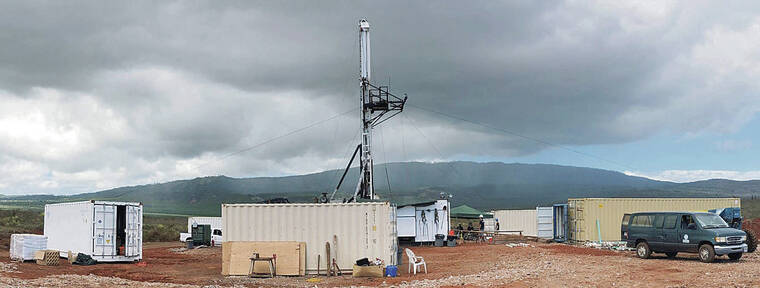Tech View: Is geothermal key to our fossil-free energy future?

UNIVERSITY OF HAWAII
This drilling site is at a water well in Palawai Basin, Lanai.

COURTESY PHOTO
Nicole Lautze:
She directs the Hawai‘i Groundwater and Geothermal Resources Center at the University of Hawaii at Manoa

The shift toward renewable energy in Hawaii captures headlines on a nearly daily basis. The goal of the state’s Hawai‘i Clean Energy Initiative is to achieve 100% clean energy by 2045. The good news is that we’re blessed with an abundance of renewable energy including offshore wind, solar, biomass, ocean, hydropower and geothermal.
Nicole Lautze, who directs the Hawai‘i Groundwater and Geothermal Resources Center at the University of Hawaii at Manoa, believes that geothermal is key to developing a Hawaii clean-energy economy.
Beneath the Hawaiian Islands lies a geological hot spot in Earth’s mantle that has been active for the past 70 million years. The Puna Geothermal Venture on Hawaii island has transformed some of this heat into electricity since it was established in the early 1980s. However, Lautze believes that the potential for geothermal electricity production is possible on every island.
The advantages of geothermal energy are compelling.
Speaking in November at an energy workshop hosted by the German honorary consul in Hawaii and the East-West Center, she explained, “Geothermal has a twofold advantage over wind and solar: production reliability and consistent pricing. Geothermal provides base-load firm energy that does not shift with sun, shade, wind or tides, and unlike petroleum resources, it is not subject to market volatility.”
So, what’s stopping us from building a geothermal-energy economy?
Don't miss out on what's happening!
Stay in touch with breaking news, as it happens, conveniently in your email inbox. It's FREE!
I had a chance to speak to her recently about this subject.
Question: How viable is geothermal as a source of renewable energy in Hawaii?
Answer: The truth is that we don’t really know yet, outside of Kilauea’s East Rift Zone, which is where exploration was focused in 1970s and has vast potential (but is also an area of high natural-hazard risk). A statewide geothermal resource assessment published by Donald Thomas in 1985 provided evidence (for example, warm groundwater) of a potential geothermal resource on all islands in the state; a more recent statewide assessment that I led (e.g., Lautze et al., 2020) came to the same conclusion, but we need to get more conclusive data to know for sure.
Q: Does hydrogen also offer a potential source of energy production for Hawaii?
A: Hydrogen production and CO2 capture are also gaining global attention as planet-saving technologies. Both technologies consume large amounts of electricity and so pair perfectly with low-cost, firm geothermal. For example, when consumers do not need the maximum electricity output of a geothermal plant (say, at night), the geothermal electricity can be producing H2 or capturing atmospheric CO2.”
Q: So, how do we get some conclusive answers about the viability of geothermal in Hawaii?
A: The “data collection” path forward would be through: a) geophysics, which is placing instruments on the ground surface to get an image of the subsurface; and b) slim-hole drilling, which is to drill very small-diameter (3- to 5-inch) boreholes quite deep (about 2 kilometers) while collecting rock core. Geophysics helps us to target the well drilling; the well drilling provides conclusive data on the chemistry and temperature of subsurface fluids. We gain a vast amount of information about the subsurface of our islands when performing both activities, including that we also learn about potential deep freshwater sources, the rock characteristics that influence groundwater storage and flow, the volcanic evolution of our islands, and we collect data necessary to consider eventual carbon sequestration and storage.
Q: What are the risks/downsides of geothermal exploration and production?
A: The geothermal exploration phase — groundwater sampling, geophysics and slim-hole drilling is completely safe with no major risks or environmental impacts. (Even the drilling can take place on about 1 acre of land). Geothermal production requires some land use; however, globally, geothermal has the smallest land use per electricity output.
For example, in Hawaii our one geothermal power plant — Ormat’s Puna Geothermal Venture — occupies about 20% of the land mass of Oahu’s largest solar plant but provides roughly five times the amount of electricity. In terms of production, so long as the resource is responsibly managed, there are little to no downsides outside of minor aesthetic complaints such as noise and lights associated with drilling, and odor of volcanic gases.
Q: If this is a potentially viable, safe source, what’s hindering us?
A: Misinformation; fear; overly stringent state regulations specifically for geothermal, which increase time/cost; (and) lack of funding.
Rob Kay, a Honolulu-based writer, covers technology and sustainability for Tech View and is the creator of fijiguide.com Opens in a new tab. He can be reached at Robertfredkay@gmail.com.




